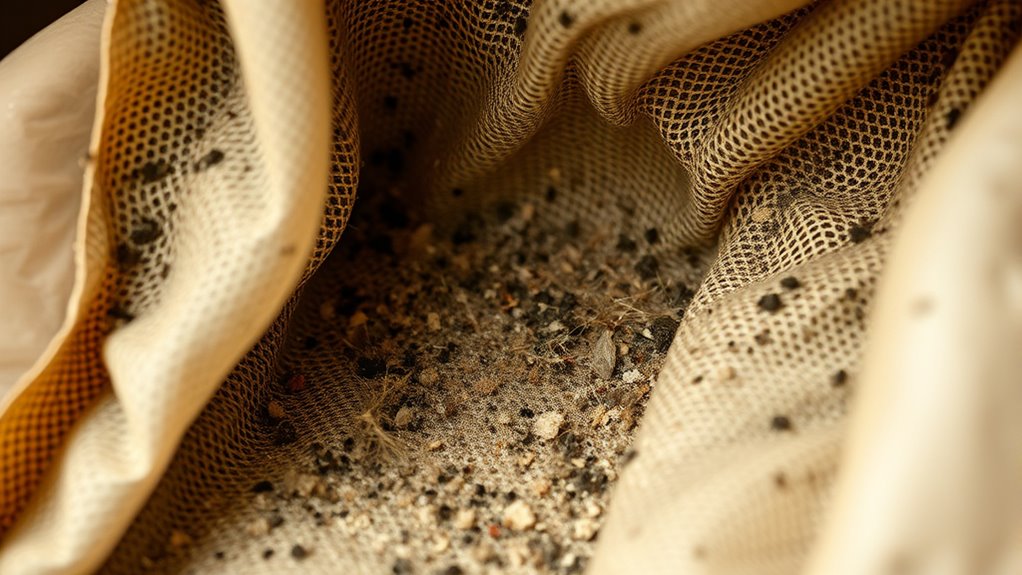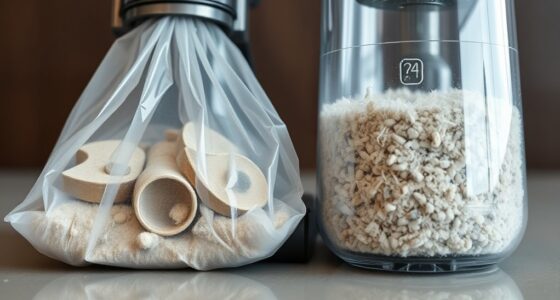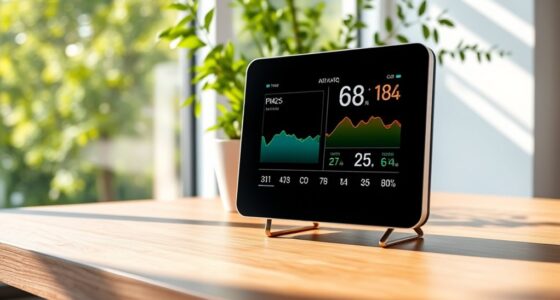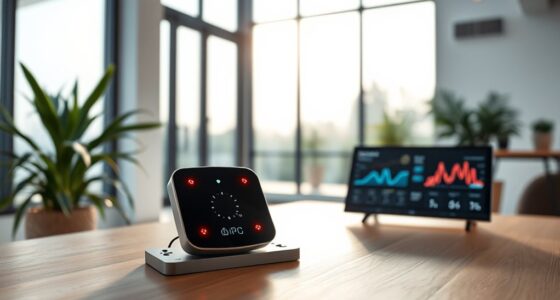Your vacuum cleaner bag hides more than dirt—it’s a breeding ground for allergens, bacteria, and mold spores that can escape if the bag is damaged or overfilled. Poor sealing or prolonged use allows these tiny health hazards to become airborne, worsening allergies and respiratory issues. Regularly replacing and properly disposing of your vacuum bag reduces these risks. Keep going for tips on maintaining a cleaner, safer vacuum environment and ways to prevent these hidden dangers.
Key Takeaways
- Vacuum bags can harbor mold spores, bacteria, and allergens that may become airborne during disposal or use.
- Poorly sealed or overfilled bags increase the risk of dust, microbes, and allergens escaping into indoor air.
- Microbial growth inside bags and dust containers can lead to health issues like allergies, asthma, and respiratory problems.
- Dust and microbial buildup in bags can cause decreased vacuum efficiency and potential health hazards if not regularly maintained.
- Proper disposal and regular replacement of vacuum bags are essential to prevent hidden microbial growth and airborne health risks.
Common Contaminants Found in Vacuum Bags
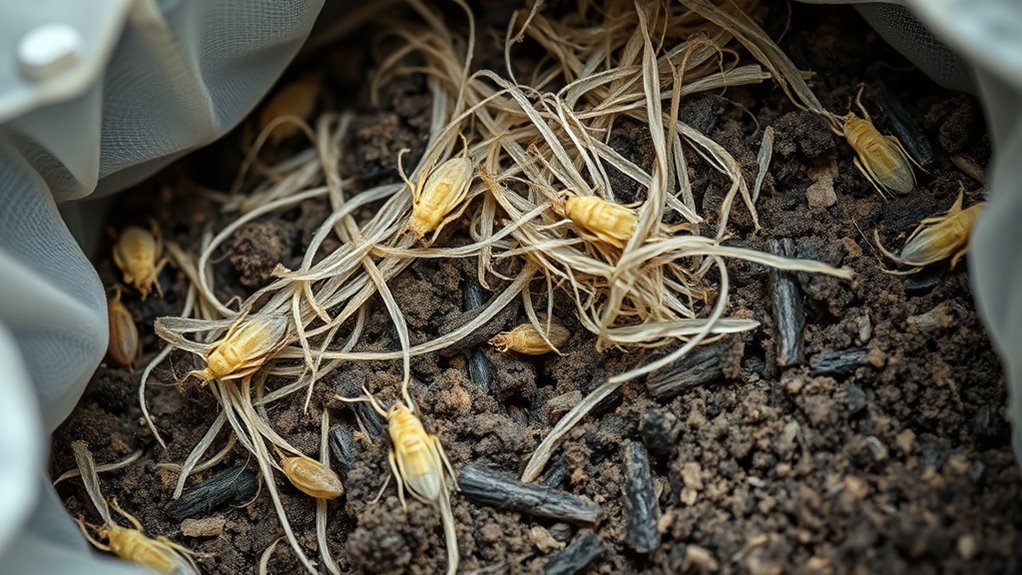
Vacuum bags often contain more than just dust and dirt; they can harbor a variety of harmful contaminants. The vacuum bag composition includes tiny particles like pollen, pet dander, bacteria, and mold spores, which can become airborne when disturbed. Poor bag sealing techniques can allow these allergens and microbes to escape, increasing health risks. When you don’t guarantee a proper seal, dust and particles can leak out during disposal or use, spreading contaminants throughout your home. Proper filter maintenance and timely replacement are essential for minimizing these risks. Understanding how your vacuum bag is constructed and sealing it correctly helps contain these dangers. Using high-quality bags with secure seals minimizes exposure to harmful substances. Paying attention to bag sealing techniques is essential for maintaining a healthier environment and reducing airborne allergens that can affect your well-being.
How Allergens Accumulate and Impact Your Health
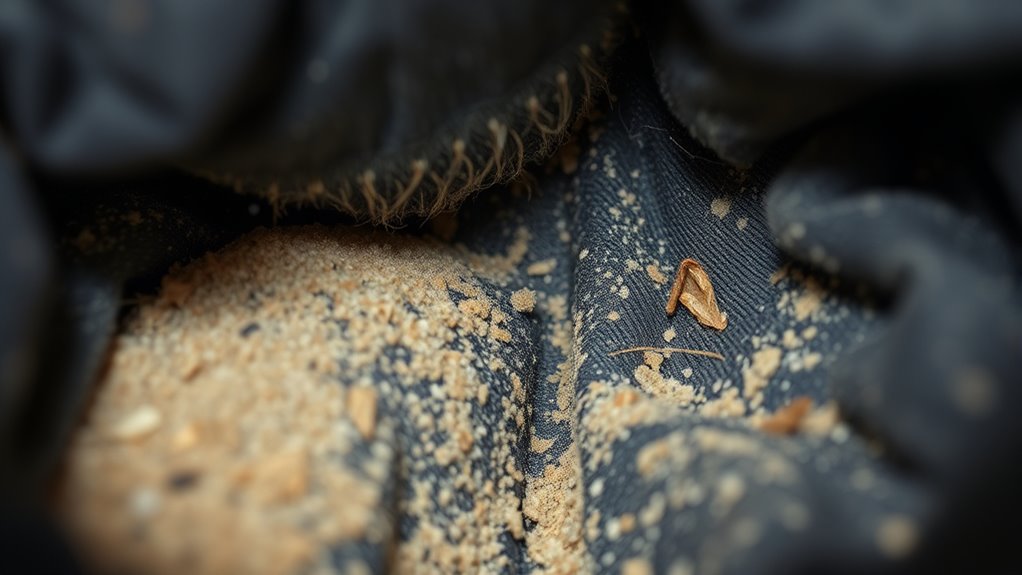
When you vacuum, dust and pet dander stick to your bag, building up over time. Mold spores and bacteria can also settle inside, creating hidden allergens. These allergens can worsen allergies or trigger respiratory issues, affecting your health more than you might realize. Regular cleaning and replacement of vacuum bags can help minimize allergenic buildup and improve indoor air quality.
Dust and Pet Dander
Have you ever wondered how dust and pet dander quietly build up in your home? These tiny particles settle into carpets, furniture, and even your vacuum bag, gradually reducing your air quality. As you go about your day, these allergens become airborne, especially when disturbed by cleaning or movement. Over time, they can trigger allergy symptoms, asthma, or other respiratory issues. Understanding how dust and pet dander accumulate helps you take steps toward allergy prevention. Regularly emptying your vacuum cleaner bag and choosing models with good filtration can markedly cut down allergen levels. Keeping your home environment clean minimizes the risk of allergens circulating and improves overall air quality, making your space healthier and more comfortable for everyone. Additionally, filtration efficiency plays a crucial role in capturing these tiny particles and preventing them from being released back into your indoor air.
Mold and Bacteria
Ever wonder how mold and bacteria find their way into your home, quietly growing in hidden corners? These microbes often hitch a ride on dust, pet dander, and moisture trapped in your vacuum bag. When you don’t regularly change or clean your vacuum filter allergens, mold spores and bacteria can thrive, releasing harmful particles back into the air. This buildup directly impacts your air quality, making allergy symptoms worse and increasing respiratory risks. Imagine:
- Mold growing unnoticed in damp, dark vacuum compartments
- Bacteria multiplying on collected debris
- Spores being redistributed into your living space with each vacuuming session
Proper maintenance of cleaning tools can prevent microbial growth and improve indoor air quality.
The Growth of Bacteria and Mold in Dust Containers

As you regularly empty your vacuum cleaner dust container, you might not realize that it creates an ideal environment for bacteria and mold to thrive. The warm, damp conditions combined with organic debris promote microbial growth. The vacuum filtration system can trap moisture and particles, providing a perfect breeding ground. Your bag material also plays a role; porous or poorly sealed bags retain moisture longer, encouraging mold development. If you don’t clean or replace the dust container frequently, these microbes can multiply quickly. Over time, bacteria and mold can become airborne when you vacuum again, releasing spores into your home. To minimize this risk, make sure to empty and clean your dust container regularly, and consider using high-quality, moisture-resistant bag materials to reduce microbial growth. Recent advancements in AI technology can also help monitor and alert you when your vacuum components need cleaning or replacement.
Risks of Prolonged Use Without Replacing Bags
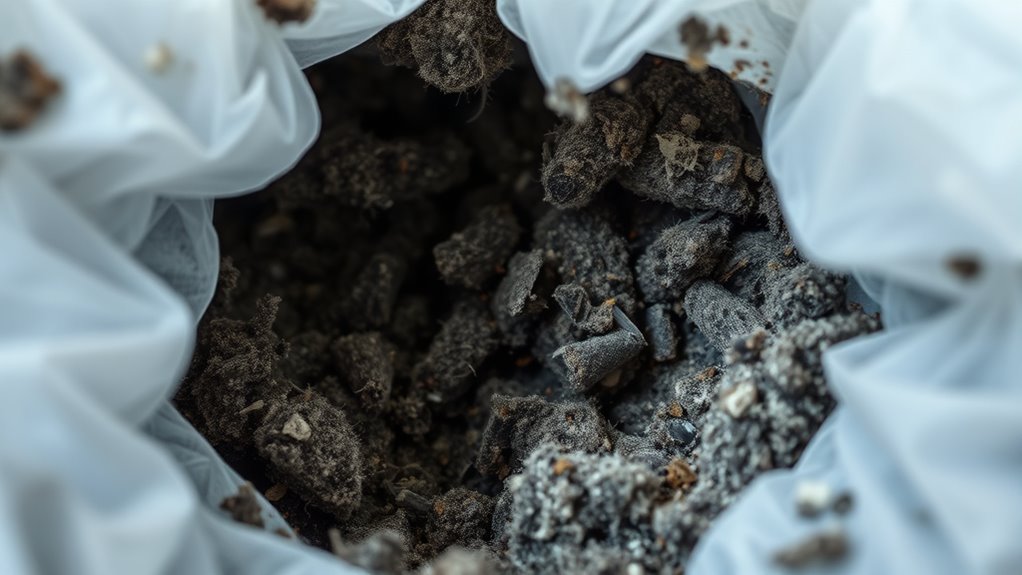
When you keep using the same vacuum bag for too long, airflow can become blocked, making your vacuum less effective. This also creates a perfect environment for bacteria and mold to grow. Ignoring bag replacement puts your health and vacuum’s performance at risk.
Airflow Blockages Increase
Have you noticed your vacuum cleaner not performing as efficiently as it used to? Airflow blockages are likely to blame. When bags aren’t replaced regularly, debris builds up, restricting airflow and reducing suction power. Over time, this causes your vacuum to strain, making it harder to pick up dirt. To prevent this, focus on filter maintenance and airflow diagnostics to spot blockages early. Visualize:
- Dust and lint clogging the hose
- Debris-packed filters impeding airflow
- Blocked vents with trapped dirt
These obstructions force your vacuum to work harder, risking motor burnout and decreasing cleaning effectiveness. Regularly checking and clearing blockages guarantees smooth airflow, keeps your vacuum functioning at its best, and extends its lifespan. Proper airflow management is essential to maintain optimal performance. Don’t ignore signs of reduced suction; swift maintenance makes all the difference.
Bacterial Growth Risks
Did you know that leaving a full vacuum bag in place can lead to harmful bacterial growth? Over time, the vacuum bag’s lifespan extends, providing an ideal environment for bacterial proliferation. As dust and debris accumulate, moisture often gets trapped, creating perfect conditions for bacteria to thrive. This bacterial growth not only worsens indoor air quality but can also trigger allergies and respiratory issues. The longer you wait to replace your vacuum bag, the higher the risk of bacteria spreading into your home every time you vacuum. Regularly changing the bag minimizes bacterial proliferation and keeps your environment healthier. Don’t ignore the signs of a full bag—timely replacement is essential to prevent bacterial risks and maintain maximum vacuum performance.
Signs That Your Vacuum Bag Needs Immediate Attention
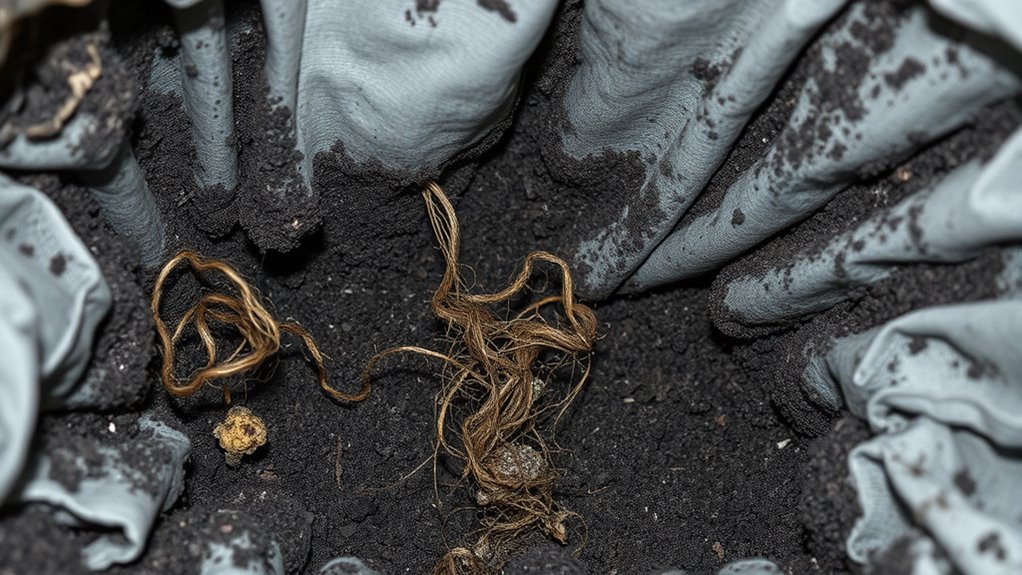
A clear sign that your vacuum bag needs immediate attention is a noticeable drop in suction power. When your vacuum struggles to pick up dirt efficiently, it’s often due to a full or damaged bag. Check the vacuum bag durability; if it’s torn or overly stuffed, it can’t contain debris properly. Also, poor filter compatibility can cause clogging, reducing airflow and suction. Additionally, ensure your vacuum’s credit card security features are up-to-date if you use digital payments for maintenance or supplies. Look for these signs:
A sudden loss of suction indicates a full or damaged vacuum bag affecting performance.
- Debris spilling out of the bag or gaps around the seal
- Reduced airflow, making cleaning more effortful
- Unpleasant odors lingering after vacuuming
If your bag is overfilled or incompatible with your vacuum model, it’s time to replace it. Regularly inspecting these signs guarantees peak performance and prevents hidden dangers.
Proper Disposal and Maintenance Tips for Safety
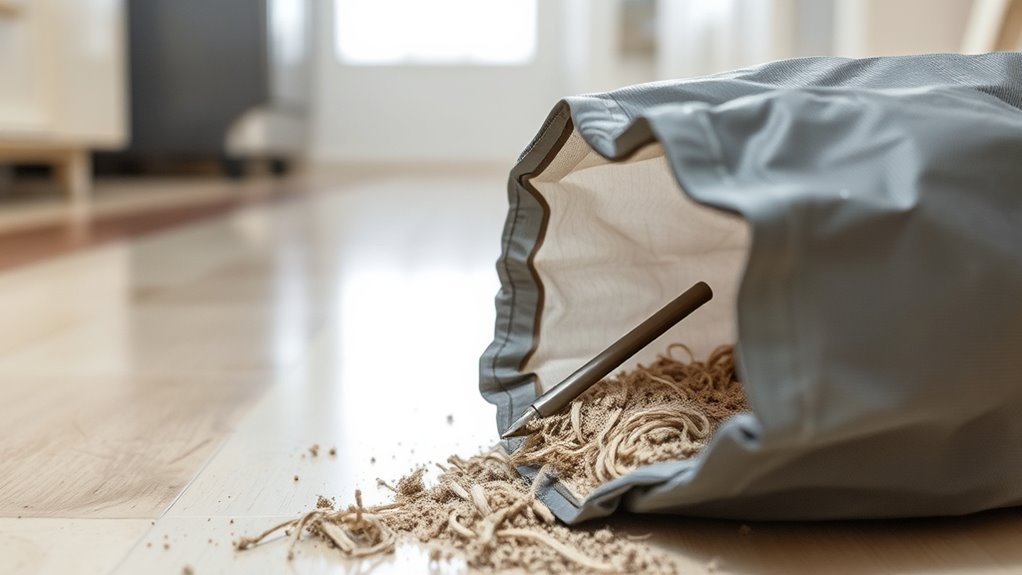
To guarantee your safety and maintain your vacuum cleaner’s performance, it’s essential to dispose of used vacuum bags properly and handle maintenance with care. When it’s time to replace the bag, carefully remove it without shaking to prevent dust from escaping into the air. Seal the bag tightly before disposal to contain any potentially harmful particles. Always follow your manufacturer’s instructions for vacuum bag disposal to avoid damage or exposure. Practice maintenance safety by unplugging the vacuum before opening it and wearing gloves if necessary. Regularly check for signs of wear or damage during maintenance to prevent leaks or reduced efficiency. Proper disposal and cautious maintenance protect you from dust exposure and keep your vacuum running smoothly. Additionally, inspecting your vacuum’s textile components regularly can help identify wear or damage early, ensuring optimal operation and safety.
Alternatives to Traditional Vacuum Bags for Cleaner Air
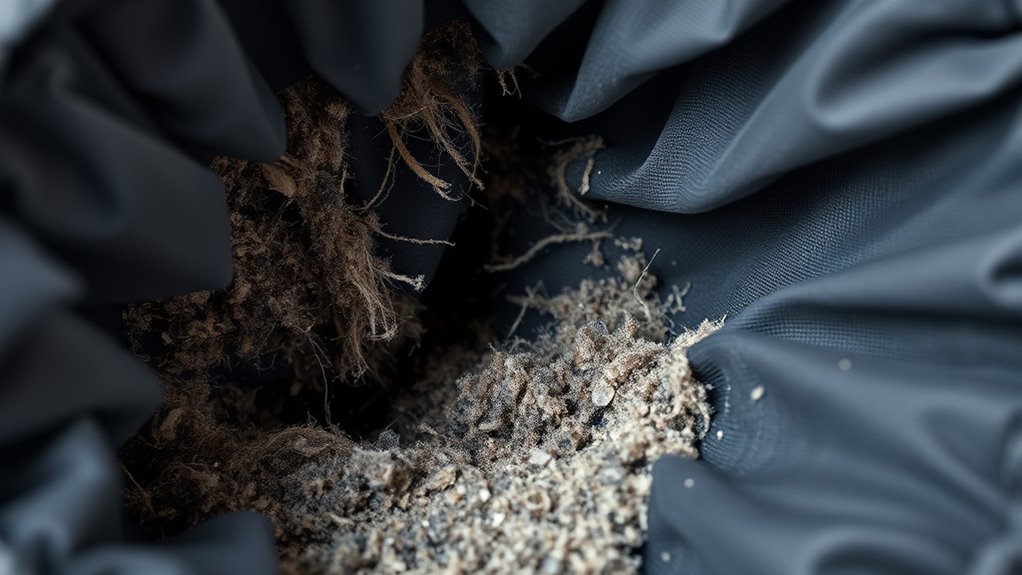
If you’re aiming for cleaner indoor air, exploring alternatives to traditional vacuum bags can make a noteworthy difference. HEPA filtration systems capture tiny particles, preventing allergens from recirculating into your home. Reusable collectors offer an eco-friendly and cost-effective option, reducing waste and ongoing expenses. These alternatives improve air quality by trapping dust, pet dander, and pollutants more effectively than standard bags. Visualize a vacuum with:
- A sleek HEPA filter that traps even microscopic allergens
- A sturdy, easy-to-clean reusable collector that holds more debris
- An advanced sealing mechanism that prevents dust escape during disposal
Switching to HEPA filtration and reusable collectors can notably reduce airborne irritants, helping you breathe easier and maintain a healthier home environment. Additionally, integrating advanced automation technology in vacuum systems can further enhance cleaning efficiency and reduce manual effort.
Frequently Asked Questions
Can Vacuum Bag Contaminants Cause Long-Term Health Issues?
You might wonder if vacuum bag contaminants can cause long-term health issues. They can, because airborne toxins and microbial buildup accumulate over time, especially if you don’t empty or replace bags regularly. Breathing in these airborne toxins can lead to respiratory problems or allergies. To protect yourself, change your vacuum bag often, and consider using HEPA filters to reduce microbial buildup and airborne toxins.
Are There Specific Allergens That Accumulate More in Vacuum Bags?
You might notice that certain allergens, like pet dander, pollen, and dust mites, tend to accumulate more in vacuum bags. These types of dust and allergen buildup can worsen allergies or asthma symptoms over time. Regularly changing your vacuum bag helps reduce this buildup, preventing allergens from lingering in your home. Keep an eye on your vacuum’s bag to minimize exposure and protect your health.
How Often Should I Replace My Vacuum Bag for Optimal Safety?
You might think waiting longer saves money, but neglecting proper vacuum bag replacement can risk your health. For maximum safety, replace your vacuum bag regularly, ideally every 1-3 months, depending on your usage. This ensures the vacuum bag lifespan stays effective, preventing allergen buildup and maintaining air quality. Don’t let complacency compromise your well-being—stay proactive with your vacuum’s maintenance for a cleaner, safer home.
Do Vacuum Bag Materials Release Harmful Chemicals Over Time?
You might wonder if vacuum bag materials release harmful chemicals over time. Some bags contain materials that emit chemical emissions, especially as they age or degrade. To guarantee your safety, check the material safety information of your vacuum bags and replace them regularly. This helps prevent exposure to potentially harmful chemical emissions, keeping your home healthier and reducing the risk of respiratory irritation or allergic reactions.
Can Vacuum Bags Be a Fire Hazard if Not Maintained Properly?
Think of your vacuum bag as a ticking time bomb if not maintained properly. Without regular emptying and inspection, dust and debris can accumulate, increasing the risk of a vacuum bag fire. Improper maintenance makes your vacuum more prone to overheating and sparks. Stay vigilant—clean and replace your vacuum bags regularly to prevent a dangerous vacuum bag fire. Proper care keeps your home safe and your vacuum running smoothly.
Conclusion
If you ignore the hidden dangers lurking in your vacuum bag, you’re inviting unseen threats into your home’s air. Imagine tiny bacteria and allergens quietly multiplying, turning your cleaning routine into a silent health hazard. Regularly check, replace, and dispose of your vacuum bag properly to keep these dangers at bay. With mindful maintenance, you’ll breathe easier, knowing your home’s air is clear and safe—turning your cleaning routine into a shield rather than a source of harm.
